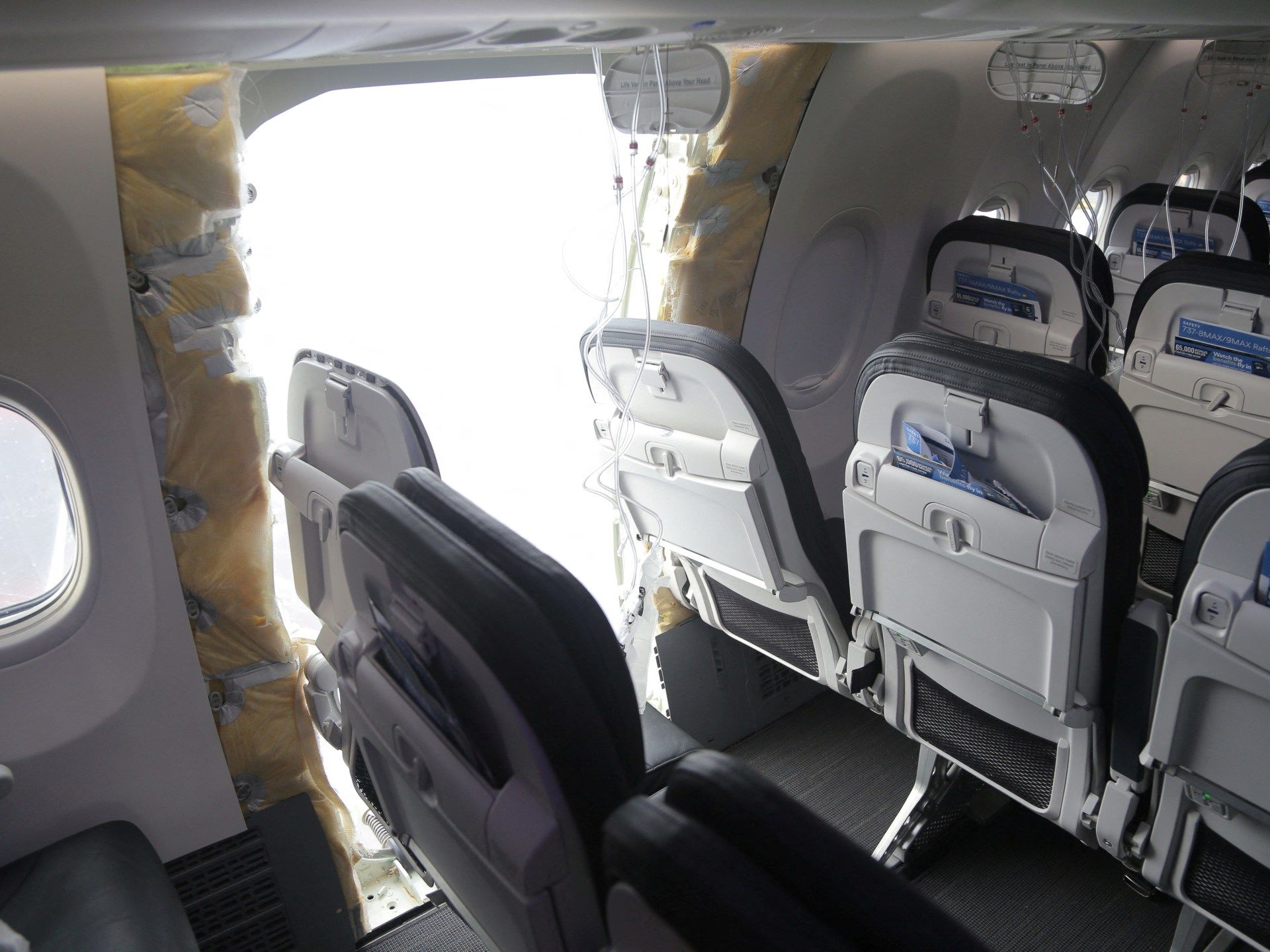Last week, an Alaska Airlines Boeing 737 Max 9 plane was forced to make an emergency landing in Portland, United States, when a cockpit panel exploded in mid-air, leaving a gaping hole in the plane's fuselage. Just days earlier, a Japan Airways Airbus collided with a smaller coast guard plane, causing the Airbus to catch fire.
The Federal Aviation Administration (FAA) ordered an investigation into the incident and several passengers filed a class-action lawsuit against Boeing in Washington state on Thursday.
So is it really safe to travel by plane? Here's what we know about the Alaska Airlines incident and overall aviation safety:
What happened to the Alaska Airlines flight?
On January 5, moments after takeoff, a cabin door panel exploded in mid-air during an Alaska Airlines flight from Portland to Ontario, leaving one side of the plane's body with a gaping hole, reducing air pressure. in the cockpit and caused an emergency landing. The burst door panel was later discovered by a Portland teacher in his yard.
US federal officials have ordered the temporary grounding of all Boeing 737 Max 9 aircraft until they can be inspected.
The cockpit panel that flew off was a “door plug” installed over an additional emergency exit door, which had been removed.
Fortunately, there was no one sitting next to the gaping hole. Furthermore, the plane was only 16,000 feet (4,876 meters) above the ground. Aircraft typically fly above 31,000 feet (9,448 meters) when they are at their highest point. If the plane had been much higher, the pressure difference could have been large enough to suck passengers out of the plane, former FAA accident investigator Jeff Guzzetti told the Washington Post.
The plane, which had taken off from Oregon bound for California, landed safely in Portland with its 174 passengers and six crew members, most of them unharmed. Some passengers suffered minor injuries.
The plane is a new Boeing 737 Max 9 that was delivered to Alaska Airlines in late October and certified safe by the FAA in early November. He had only been in service for eight weeks.
London-based independent aviation expert John Strickland told Al Jazeera that the panel that took off is assumed to be a safe part of the airframe. “That's why it's all the more surprising and worrying that this explosion occurred,” he said.
Alex Macheras, a London-based aviation analyst and consultant, agreed: “This should not be downplayed, that's for sure. Because in modern commercial aviation, we don't see sections of the body of an airplane, the fuselage, separating from the rest of the airplane, much less in mid-flight.”
Has Boeing taken responsibility?
As more than 170 planes remained grounded last week, Boeing CEO Dave Calhoun acknowledged the mistakes Boeing made and provided reassurance. He told staff that the company would make sure an incident like the one at Alaska Airlines never happened again. It has not been confirmed what the actual fault was with the plane, although experts told Al Jazeera it was most likely due to a manufacturing defect rather than a design defect. There has also been speculation about parts coming loose after Alaska Airlines and United Airlines reported incidents of needing to tighten loose hardware last Monday.
Earlier, the US's chief accident investigator, the National Transportation Safety Board (NTSB), said it had received reports that warning lights had been activated on new Boeing 737 Max 9 planes on three flights. Two of these alerts occurred on consecutive days before the Alaska Airlines explosion.
Richard Aboulafia, an aviation industry analyst and CEO of Washington-based AeroDynamic Advisory, told Al Jazeera that the warning lights were likely the result of a technical fault. “They ignored it because, strangely, the pressure differential appeared while he was on the ground, meaning it was a technical problem. There is no pressure difference while you are on the ground,” he explained. Cabin pressure can only vary when the plane is in the air, so it was acceptable to ignore the warning and fly the plane over the ground, he said.
The company stopped flying the plane over the Pacific Ocean to Hawaii because of the warnings, but kept it flying over land, the NTSB said.
Who controls the safety of an airplane?
Aboulafia explained that the FAA typically certifies an aircraft, approving its operations and production.
However, since the Boeing 737 Max has had safety issues before, the FAA announced that it would inspect each and every Max series aircraft under these unusual circumstances. Details about the exact checks that were carried out are not public.
Once the plane is in use by an airline, periodic maintenance checks called A, B, C and D checks are carried out, Aboulafia explained. While an A check is typically a cursory investigation of an aircraft's moving parts, exterior wear, and oil and fuel, a D check is rigorous and involves a detailed disassembly and inspection of the aircraft.
These checks are carried out at specific intervals based on the number of years an aircraft has been in service or its number of flight hours. Some airlines have their own internal capabilities to carry out these checks and while many airlines can carry out checks A or B, only some airlines can carry out checks C or D themselves. Others use third-party services.
“This is an unprecedented increase in production and clearly more resources need to be provided, whether at the manufacturing level or inspections,” Aboulafia added, referring to how aircraft are now manufactured in large quantities. He called for more people to be allotted more time for inspections.
Aboulafia added that it is imperative to identify where and how the Alaska plane passed its safety checks, and whether it was Boeing, Spirit Aerosystems or the FAA that approved the plane without a detailed inspection. There is no information on the level of detail of the inspection that was carried out before the plane was cleared to fly.
At some or multiple stages of the process, workers or inspectors needed to be given more time to “do their job,” however, Aboulafia said, adding: “We don't know yet, but clearly, there was a gap.” on how things should have been done.”

Have Boeing 737 planes had problems before?
Yes. Planes were grounded around the world for about two years after one crash killed 189 people in Indonesia in October 2018 and another killed 157 in Ethiopia five months later.
In both cases, a design flaw was found in the automated flight control software, which was erroneously activated. The Boeing 737s were cleared to fly again once the plane was refurbished with an improved flight control system.
Aboulafia said the crashes in Indonesia and Ethiopia were caused by design defects in the flight control system, while the recent incident was a manufacturing defect, albeit with loose hardware on the planes.
United Airlines and Alaska Airlines reported Monday that there was loose hardware that required additional adjustment on several grounded Boeing 737 Max 9 planes, raising new concerns among industry experts about the manufacturing process.
If a design problem occurs, the design defect must be corrected in the plane before the plane model is cleared to fly again, he explained.
For manufacturing defects, “you have to identify where the errors were made, and then it is an easy inspection, especially because it is structural and not software or anything like that,” he added.
Why does turbulence increase?
A June 2023 study by the UK's University of Reading showed that severe air turbulence had increased by 55 percent at an average point over the North Atlantic between 1979 and 2020.
The study concluded that turbulence will worsen with climate change and the calculated increase is consistent with the expected effects of climate changes. Therefore, the increase in turbulence is not due to poor aircraft design or manufacturing.
Is air transport still the safest means of transport?
Research from Harvard University has found that the chances of suffering a plane crash are one in 1.2 million, while the chances of dying in such an accident are one in 11 million. Meanwhile, the odds of dying in a car accident are significantly higher: one in 5,000.
“Is any means of transportation always safe? No, but if you choose not to fly and take a car, it is a much more dangerous way to travel,” Aboulafia said.












